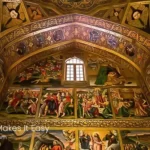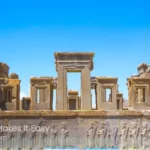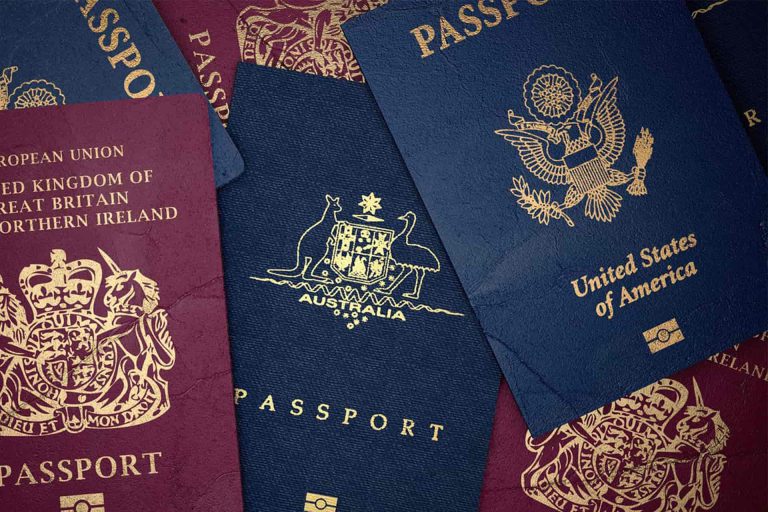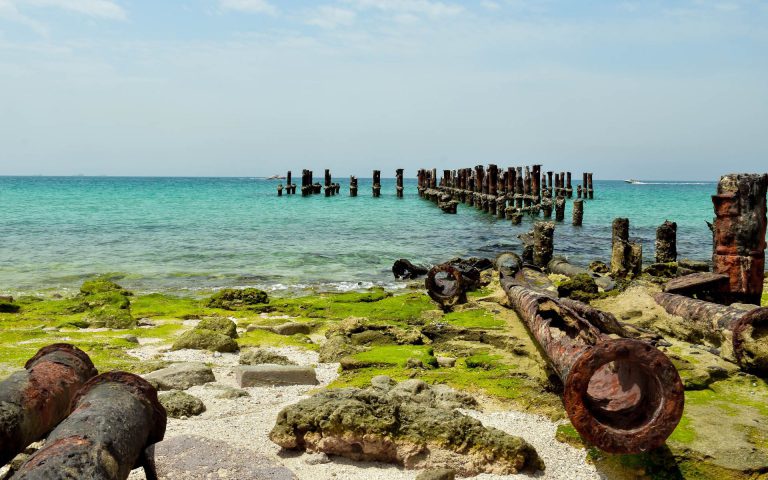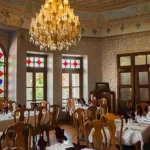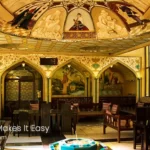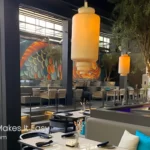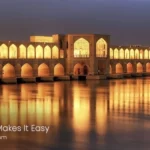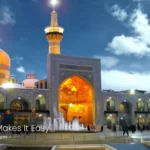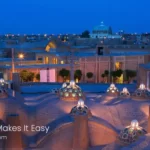Khaju Bridge is one of the historical and beautiful bridges in Isfahan province, which was once among the most beautiful bridges in the world. Walking on the bridge, especially at night and in the early evening, is one of the most enjoyable activities that tourists can experience. A visit to Isfahan, known as the ‘Half of the World,’ wouldn’t be complete without seeing this bridge. In addition to serving as a river crossing, Khaju Bridge also functions as a dam and a gathering place for the public. Over the years, it has been a popular meeting spot for locals and a source of inspiration for poets and artists. Whether you’re interested in history, architecture, or simply seeking a picturesque spot to visit, Khaju Bridge has it all. Continue reading this article to discover more about Khaju Bridge.
History of Khaju Bridge

How Old is Khaju Bridge?
Khaju Bridge is also known as the Shah Bridge, the Baba Rokneddin Bridge (leading to the monastery and the Tomb of Baba Rukneddin and Takht Fulad), and the Hasanbeig Bridge (named after the previous bridge that was destroyed during the time of Shah Abbas, and which this one replaced). It’s also sometimes called the Shiraz Bridge. This bridge built in 1650. There is an inscription in the southern part of the bridge that indicates Khaju Bridge was renovated during the reign of Naser al-Din Shah Qajar in the year 1290 Hijri (Islamic calendar).
Who Built Khajoo Bridge?
Khaju Bridge, a magnificent architectural gem, was commissioned and constructed during the reign of Shah Abbas II, a prominent ruler of the Safavid dynasty. Shah Abbas II ruled Iran during the late 17th century. Shah Abbas II’s decision to build Khaju Bridge was a testament to his commitment to improving the infrastructure of Isfahan, the capital of the Safavid Empire.
Architecture of Khaju Bridge

Khaju Bridge stands as a true architectural masterpiece, a testament to the remarkable craftsmanship and artistic talent of its time. This bridge boasts a symmetrical design featuring an impressive array of 24 arches and two levels.
The lower level of Khaju Bridge served a practical purpose as a dam, expertly designed to regulate the flow of the Zayanderud River. During drier periods, the sluice gates within the arches could be closed, allowing the storage of water. Conversely, during the wetter seasons, these gates could be opened to release water downstream. This innovative engineering concept seamlessly transformed the bridge into both a critical water management structure and a charming pedestrian bridge.
In the upper level, a central pavilion takes center stage, flanked by inviting alcoves on either side. This space serves as a delightful setting for gatherings, relaxation, and social activities. Adorned with intricate tilework, paintings, and inscriptions, the pavilion exudes an enchanting ambiance. When night falls, the bridge comes to life with its illumination, casting enchanting reflections on the water below and adding a touch of magic to the surroundings.
What is the Khaju Bridge Used for?
Khaju Bridge transcends its historical significance and architectural splendor to serve a variety of purposes over the years. Initially, it played a pivotal role as a river dam, effectively managing water resources for irrigation and agriculture, particularly during the dry spells.
However, Khaju Bridge is not just a practical structure; it’s also a cherished social hub for the local community. The upper level has been a gathering spot for people to revel in panoramic views, engage in lively conversations, and bask in the artistic adornments. It has been a place for leisurely strolls, picnics, and even musical performances, breathing life into the bridge as a vibrant center of cultural and social activities. Today, Khaju Bridge remains a sought-after destination, drawing tourists and locals alike.
Wonders of Khaju Bridge

The design of this historical bridge is quite clever; it acts like a dam, and the presence of the existing sluice gates on the openings allows for controlling the water flow and the amount of collected water. This beautiful historic bridge has 24 arches, and 21 sluices, which have caught the attention of many travelers and tourists. There are also 51 large and small chambers on both sides of the inner part of the bridge, adding to its unique features. In the following, we’ll introduce the intriguing and extraordinary features of Khaju Bridge that set it apart from other bridges situated on the Zayanderud River:
- Stone Lions
On both sides of Khaju Bridge, you’ll notice beautiful stone lions. If you stand next to one of these lions and look into the eyes of the opposite lion, their eyes seem to gleam. Some believe these two stone lions symbolize the Bakhtiari tribal warriors who bravely guarded Isfahan and the Zayanderud River. Additionally, you can see symbols of ancient sports on these sculptures.
- Bridge Foundations
One clever feature of Khaju Bridge is the use of a particular substance in its mortar. By placing the bridge’s foundations in water, the more water that reaches them, the stronger they become.
- Candle-Like Patterns
When you look from the eastern side of the bridge towards the lower openings at a 30-degree angle, you’ll see a candle-like pattern created by the overlapping openings. This pattern is especially captivating and beautiful during sunset.
- Eagle with Spread Wings
Viewing the bridge from above, it resembles an eagle with its wings outstretched. The sections of the different bridge levels form the head and wings of the eagle.
- Curved Ceilings
The curved ceilings of Khaju Bridge are designed in such a way that from the sides of its edges, there are edges facing each other. If tourists stand on opposite sides of these edges and speak softly, they can hear each other’s voices.
When is the Best Time to Visit Khaju Bridge?
The best seasons to visit Khaju Bridge are spring and fall for pleasant weather and scenic beauty. For the best experience at Khaju Bridge, consider visiting in the evening or at night to enjoy its illuminated beauty and reflections in the water. Alternatively, daytime visits allow you to appreciate the intricate architectural details, including tilework and inscriptions.
Conclusion
Khaju Bridge can be considered one of Isfahan’s renowned bridges, both in terms of its unique architecture and beauty, situated gracefully over the Zayanderud River. The intricate paintings and tilework on this historic bridge were masterfully executed, adding to its allure. If you happen to visit Isfahan, make sure to explore this historic bridge and share your experiences with us.
FAQs about Khajoo Bridge
- Why is Khaju Bridge famous?
Khaju Bridge is famous for its stunning architecture and dual-purpose design. It’s not just a beautiful bridge; it’s also a dam and a social hub. Its magical illumination at night adds to its charm, making it a must-visit in Isfahan. - How long is the Khaju Bridge?
Khaju Bridge stretches over 133 meters, making it an impressive structure that spans the Zayanderud River.


